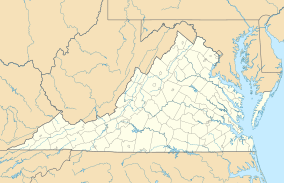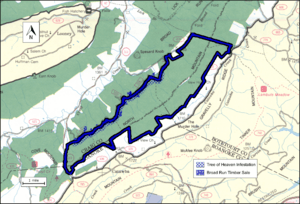North Mountain (conservation area) facts for kids
Quick facts for kids North Mountain |
|
|---|---|
| Location | Craig County Botetourt County Roanoke County Virginia, United States |
| Area | 8,409 acres (34.03 km2) |
| Administrator | U.S. Forest Service |
North Mountain is a special wild area located in the George Washington and Jefferson National Forests in western Virginia. It's a place where nature is protected from things like logging and building new roads. The Wilderness Society even calls it a "Mountain Treasure" because it's so important.
This area has many trails, making it a great spot for outdoor fun. You can enjoy quiet hikes and explore nature, all while being close to the city of Roanoke. North Mountain is also part of a larger natural area called the Craig Creek Cluster.
Contents
Exploring North Mountain: Location and Trails
North Mountain is found in the Appalachian Mountains of Southwestern Virginia. It's about 6 miles southeast of a town called New Castle, Virginia. The area is bordered by Catawba Creek Road (VA 779) on one side and Wildlife Road (Forest Road 224) on the other.
Popular Trails for Hikers
You can enter the North Mountain area using several trails:
- North Mountain Trail (Forest Trail 263): This trail is 13.2 miles long. It is considered difficult and has yellow markers.
- Deer Trail (Forest Trail 186): This trail is 1.6 miles long. It is also difficult and marked with blue blazes.
- Turkey Trail (Forest Trail 187): This trail is 1.6 miles long. It is difficult and has blue markers.
- Grouse Trail (Forest Trail 188): This trail is 1.5 miles long. It is difficult and marked with blue blazes.
Wildlife Road (Forest Road 224) also provides access to the northwestern part of the area.
Finding Your Way Around
The map next to this text shows the boundaries of the wildland, as identified by the Wilderness Society. You can find more roads and trails on National Geographic Maps, specifically map 788 (Covington, Alleghany Highlands). For lots of information, like topographic maps, aerial views, and weather, you can click the coordinates link at the top right of this page.
Besides the main trails, you can also explore old logging roads. These roads were used a long time ago when trees were harvested. Many are now overgrown but can still be walked. You can find these old roads and even old railroad paths by looking at historical maps from the United States Geological Survey (USGS). The North Mountain wild area is shown on the USGS topographic maps called Catawba and Looney.
Nature and Wildlife at North Mountain
North Mountain is part of a larger natural region known for its forests and meadows. You can find many types of trees here.
Trees and Plants
In areas with good drainage and along streams, you might see trees like yellow poplar, northern red oak, white oak, basswood, and eastern hemlock. On the north and west sides, white oak, northern red oak, and hickory trees are common. On the ridgetops and open areas, you'll find chestnut oak, scarlet oak, and yellow pine.
There's a special area on the southwest side, about 39 acres, called the Dragons Tooth Trail/McAffee Knob Special Biological Area.
Rare Plants and Animals
North Mountain is home to some very rare living things:
- A globally rare shrub called the pirate bush.
- Two rare plants: the small spreading pogonia and sword-leaved phlox.
- A rare water creature called the orangefin madtom.
Table Mountain Pine and Fire Ecology
You'll also find areas with many table mountain pine trees, especially on dry, sunny slopes. These trees often grow with mixed oak trees. Table mountain pine trees need fire to help them grow new trees. Their cones are "serotinous," meaning they need heat from a fire to open up and release their seeds. To keep these forests healthy, controlled fires are sometimes set on purpose. This helps new pine trees grow and keeps the forest in good condition.
Understanding North Mountain's Landscape
The North Mountain area is known for its long ridges that run from northeast to southwest. These ridges are made of sandstone or shale. Between the ridges, there are wide valleys with streams flowing through them.
Mountains and Valleys
North Mountain itself has small, steep slopes. The highest point is 3062 feet along the top of North Mountain. The lowest point is 1410 feet, found near the southeastern edge along VA 600.
Most of the area (about 75%) has sandstone rocks underneath. The rest of the area has shale rocks, specifically from the Brallier and Martinsburg layers.
How the Forest Service Manages North Mountain
The U.S. Forest Service looks after North Mountain. They work to protect wild areas like this one from too much development.
Protecting Wild Areas
The Forest Service has surveyed its lands to see which areas could be designated as "wilderness." Wilderness areas get a very high level of protection. Areas that are suitable are called inventoried roadless areas. Later, a "Roadless Rule" was put in place. This rule limits building new roads in these areas. It helps protect the environment by reducing the impact of road construction and promoting the conservation of roadless areas. North Mountain was part of this review, so it is protected from new road construction and large-scale timber sales.
Forest Management Activities
The Forest Service has used special methods to manage certain plants. For example, they used herbicide to control a plant called Tree of Heaven along Wildlife Road (Route 224). In 1998, a timber sale called "Broad Run" allowed people to cut firewood without building new roads or using heavy logging equipment.
The Forest Service also categorizes its lands based on the types of outdoor activities available. Most of North Mountain is called "Backcountry—Non-Motorized." This means it's a place for activities like hiking and backpacking, where motorized vehicles are not allowed. Along Wildlife Road, there are areas for "Early Successional Habitat," which means they are managed to support young plants and animals. A section in Roanoke County is also designated for "Source Water Protection," helping to keep water clean.



